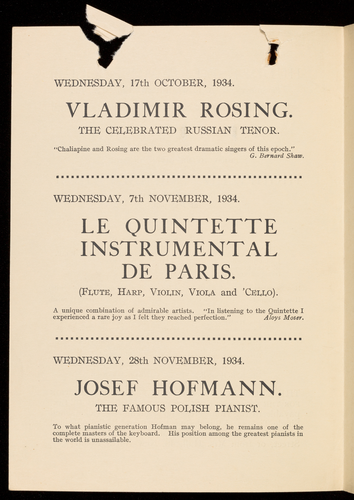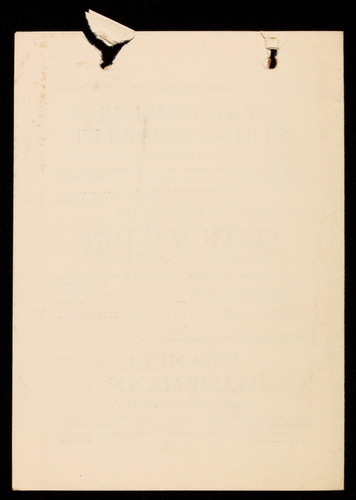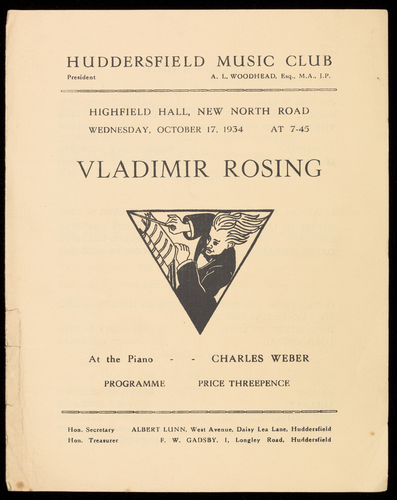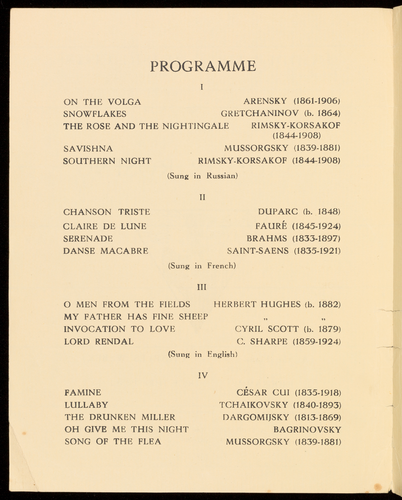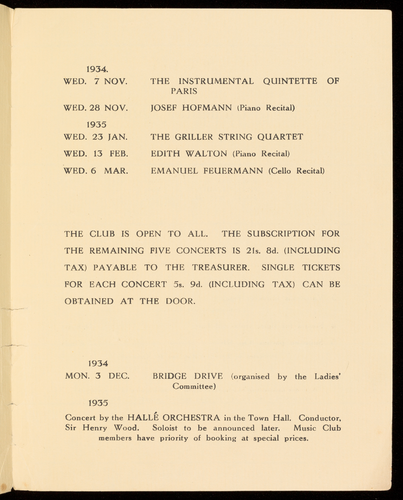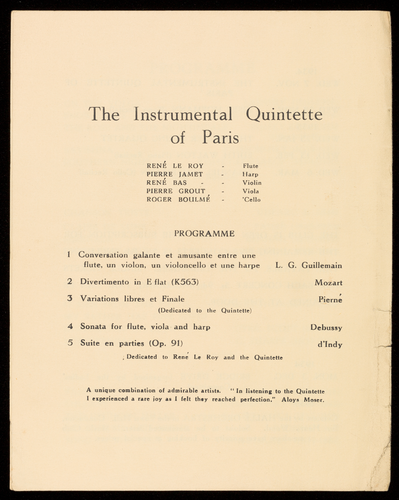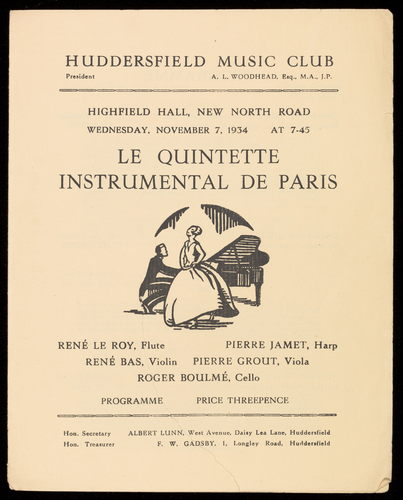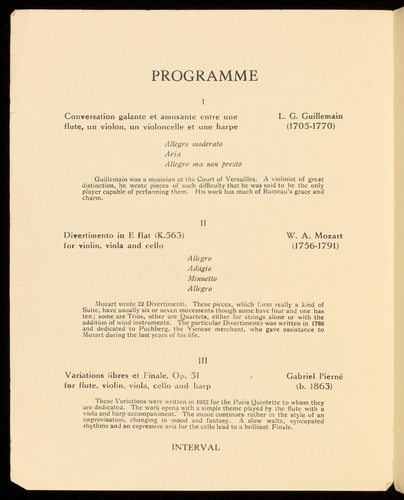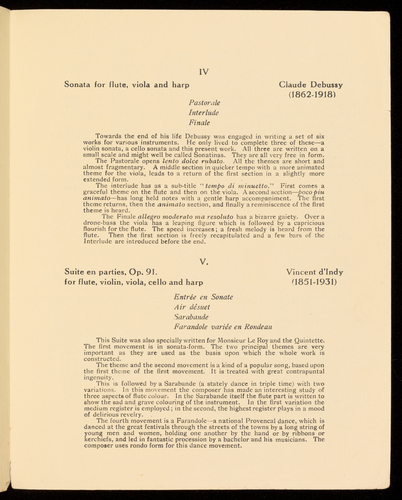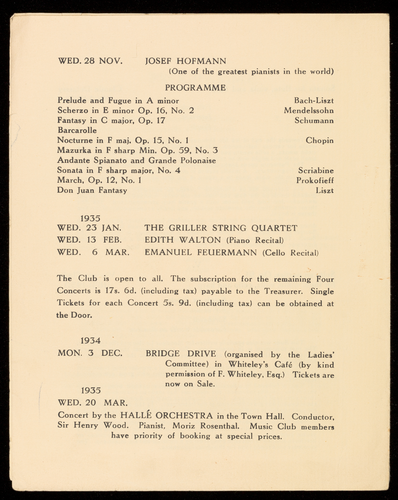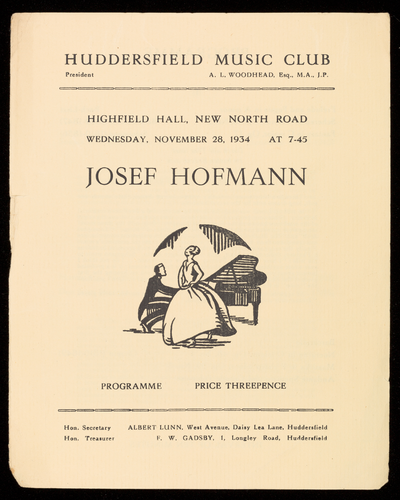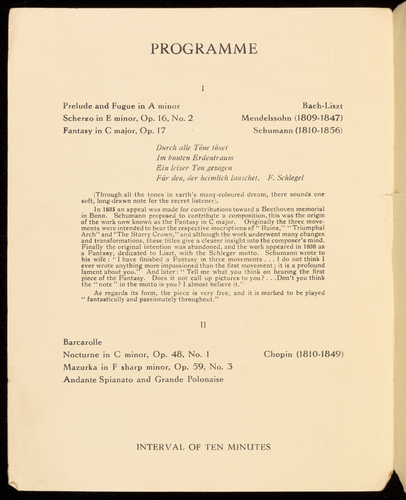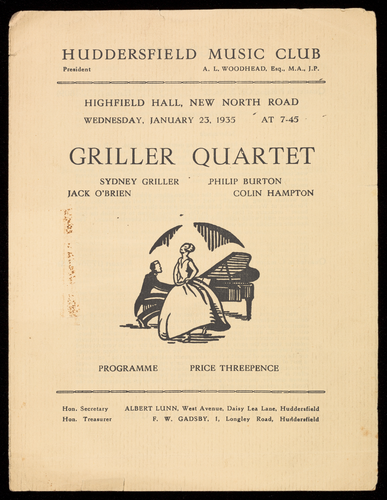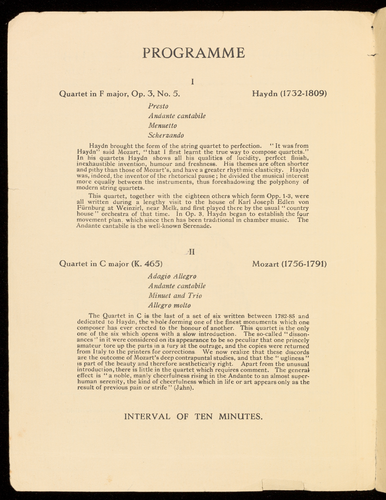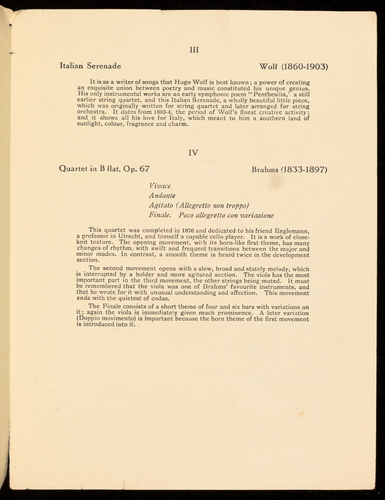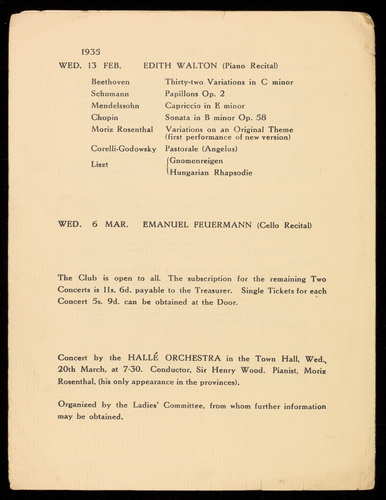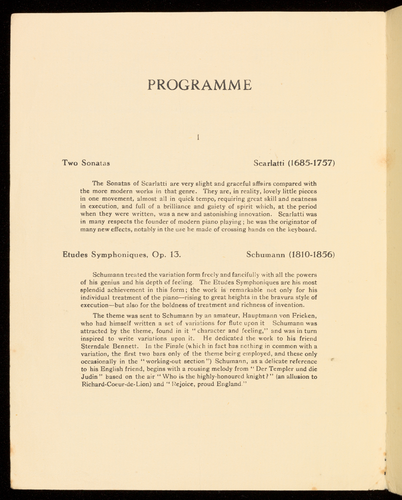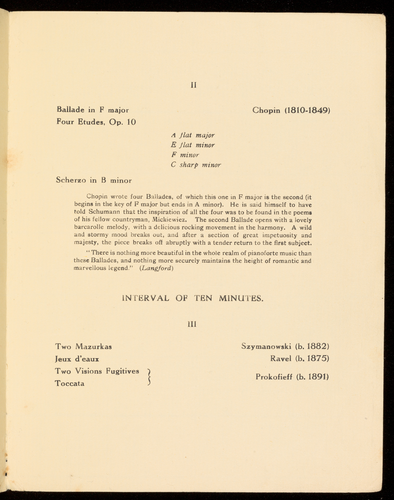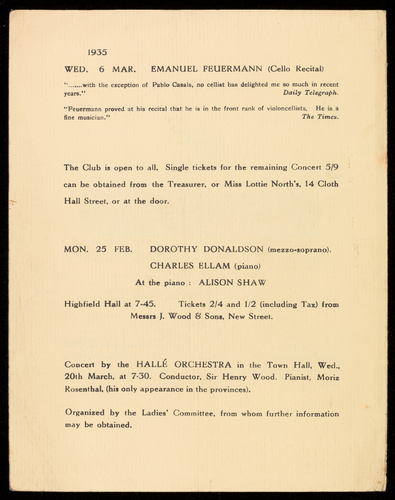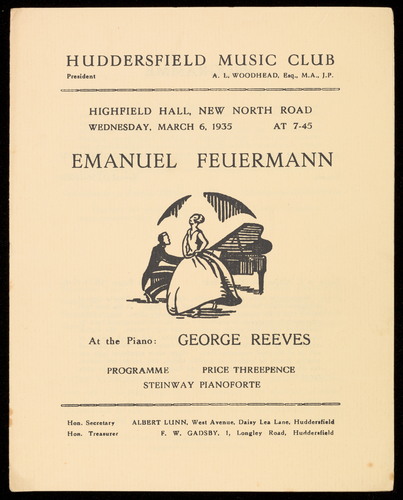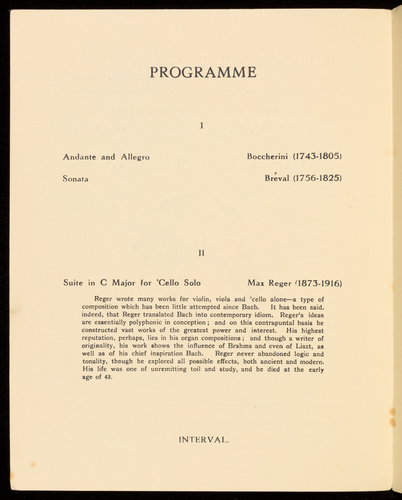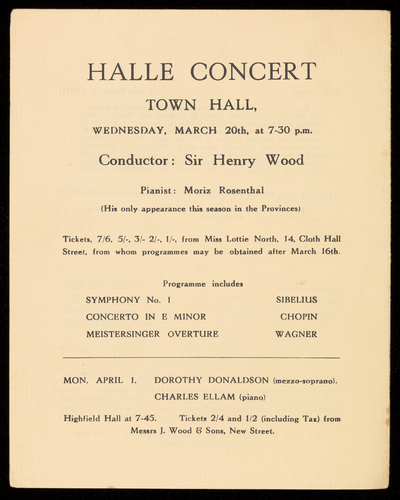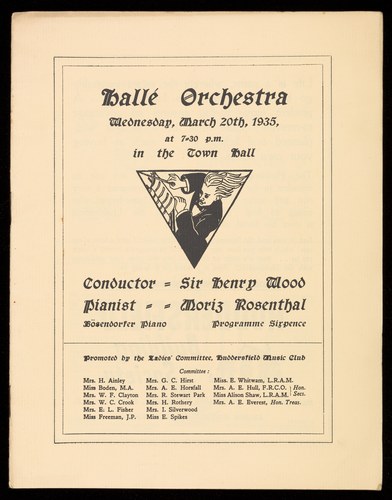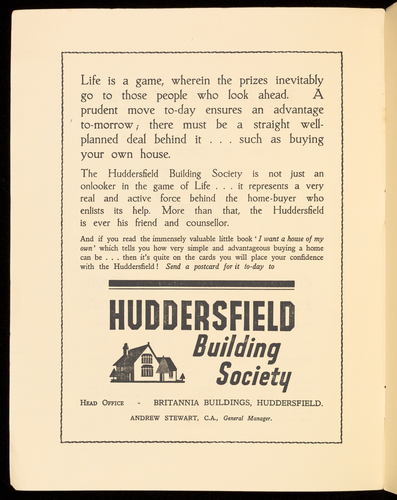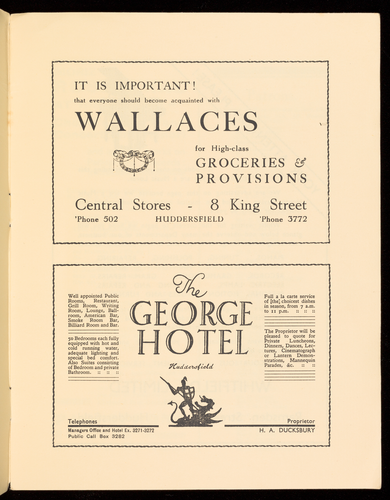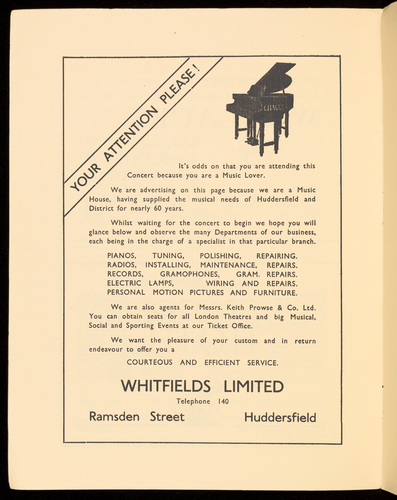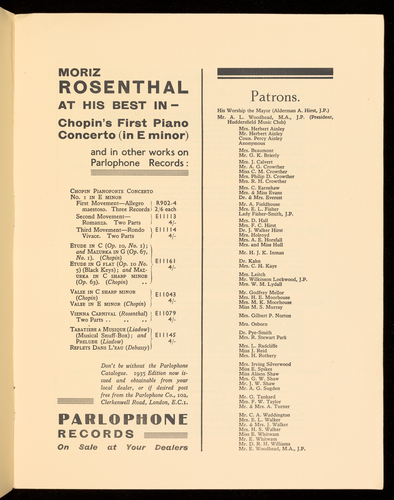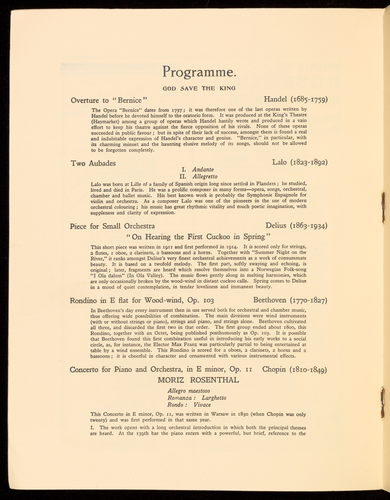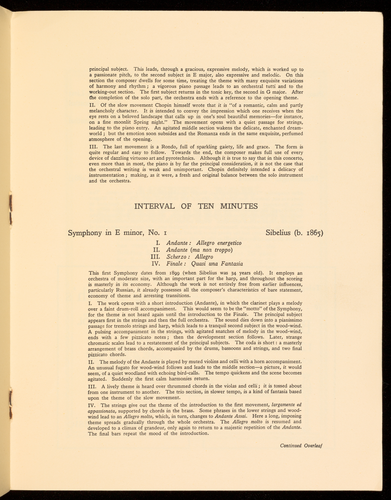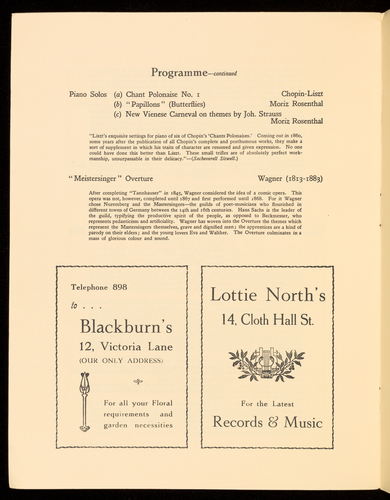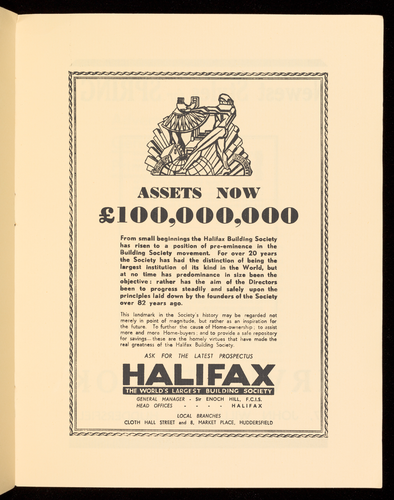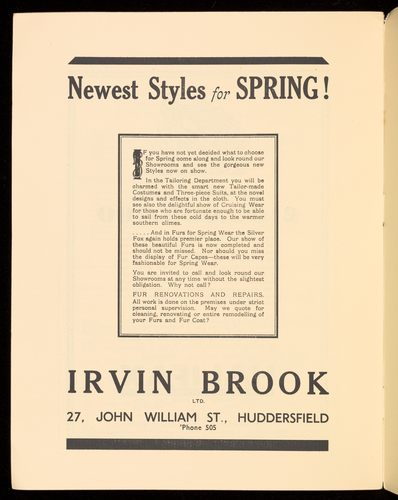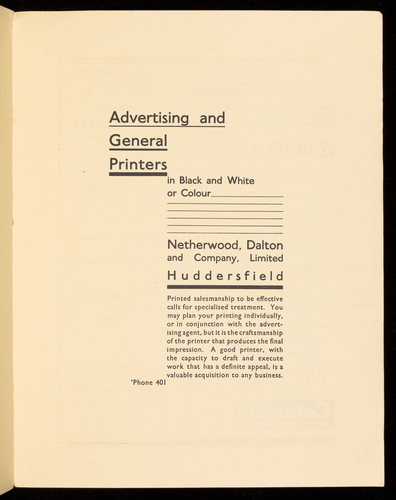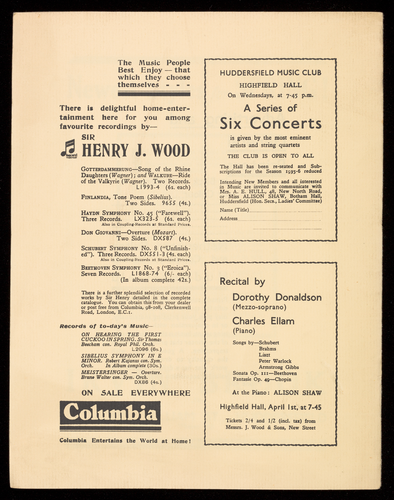Ocr'd Text:
HUDDERSFIELD MUSIC CLUB.
A. L. WOODHEAD, Esq., M.A., J.P.
45454
PRESIDENT
FYYYYY
CONCERTS
FOR THE SEVENTEENTH SEASON
1934-35 TO BE GIVEN IN THE
459
J. Stancliffe Ellis.
W. Tuke Robson.
Irving Silverwood,
HIGHFIELD ASSEMBLY HALL
(NEW NORTH ROAD)
at 7-45 p.m.
Ä
Committee:
Mrs. A. Eaglefield Hull, F.R.C.O. Miss Alison Shaw, L.R.A.M.
W. Clifford Crook.
Hon Secretary
Hon. Treasurer -
5959
●
Mrs. H. Ainley.
Miss Boden.
Mrs. W. F. Clayton.
Mrs. W. C. Crook.
Mrs. A. E. Everest.
Mrs. E. L. Fisher.
Miss Freeman, J.P.
Mrs. G. C. Hirst.
Mrs. A. E. Horsfall.
95959
F. W. Thornton, M.R.C.S., L.R.C.P.
Frederick Whiteley.
D. R. H. Williams.
ALBERT LUNN, 7, West Avenue, Daisy Lea Lane.
- F. W. GADSBY, 1, Longley Road.
Ladies' Committee:
Mrs. A. E. Hull.
Mrs. R. Stewart Park.
Mrs. H. Rothery.
Mrs. A. E. Rushworth,
Miss A. Shaw.
Mrs. Silverwood.
Miss E. Spikes.
Mrs. F. Whiteley.
Miss E. Whitwam.
THE CLUB IS OPEN TO ALL. THE SUBSCRIPTION
FOR THE SERIES OF SIX CONCERTS IS 20/10 (plus 4/2 tax)
payable to the Hon. Treasurer. Members' Tickets and
Single Tickets (5/9 including tax) may also be obtained
from Miss Lottie North, The Music Shop, 14, Cloth Hall
Street, or from Mrs. Hull, 48, New North Road.
Ocr'd Text:
WEDNESDAY, 17th OCTOBER, 1934.
VLADIMIR ROSING.
THE CELEBRATED RUSSIAN TENOR.
"Chaliapine and Rosing are the two greatest dramatic singers of this epoch."
G. Bernard Shaw.
WEDNESDAY, 7th NOVEMBER, 1934.
1
LE QUINTETTE
INSTRUMENTAL
DE PARIS.
(FLUTE, HARP, VIOLIN, VIOLA and 'CELLO).
A unique combination of admirable artists. "In listening to the Quintette I
experienced a rare joy as I felt they reached perfection."
Aloys Moser.
WEDNESDAY, 28th NOVEMBER, 1934.
JOSEF HOFMANN.
THE FAMOUS POLISH PIANIST.
To what pianistic generation Hofman may belong, he remains one of the
complete masters of the keyboard. His position among the greatest pianists in
the world is unassailable.
Ocr'd Text:
WEDNESDAY, 23rd JANUARY, 1935.
THE GRILLER
STRING QUARTET
(OF LONDON).
"The Griller Quartet have mastered the secrets of quartet playing. Their
balance is impeccable.'
Daily Telegraph.
WEDNESDAY, 13th FEBRUARY, 1935.
EDITH WALTON.
THE BRILLIANT ENGLISH PIANIST.
"Edith Walton must now be reckoned among the most accomplished pianists of
the day."
Daily Telegraph.
"A pianist of rare skill and refinement."
"An inspiration of art touches all her playing."
WEDNESDAY, 6th MARCH, 1935.
The Globe.
Vossiche Zeitung, Berlin.
EMANUEL
FEUERMANN.
A GREAT VIOLONCELLIST.
"......with the exception of Pablo Casals, no cellist has delighted me so much in
recent years."
Daily Telegraph.
"Feuermann proved at his recital that he is in the front rank of violoncellists.
He is a fine musician."
The Times
Ocr'd Text:
HUDDERSFIELD MUSIC CLUB
A. L. WOODHEAD, Esq., M.A., J.P.
President
HIGHFIELD HALL, NEW NORTH ROAD
WEDNESDAY, OCTOBER 17, 1934
VLADIMIR ROSING
At the Piano
PROGRAMME
AT 7-45
-
CHARLES WEBER
PRICE THREEPENCE
Hon. Secretary ALBERT LUNN, West Avenue, Daisy Lea Lane, Huddersfield
Hon. Treasurer
F. W. GADSBY, 1, Longley Road, Huddersfield
Ocr'd Text:
PROGRAMME
SAVISHNA
SOUTHERN NIGHT
ON THE VOLGA
SNOWFLAKES
THE ROSE AND THE NIGHTINGALE
CHANSON TRISTE
CLAIRE DE LUNE
SERENADE
DANSE MACABRE
LORD RENDAL
FAMINE
LULLABY
I
(Sung in Russian)
ARENSKY (1861-1906)
GRETCHANINOV (b. 1864)
MUSSORGSKY (1839-1881)
RIMSKY-KORSAKOF (1844-1908)
II
THE DRUNKEN MILLER
OH GIVE ME THIS NIGHT
SONG OF THE FLEA
(Sung in French)
III
O MEN FROM THE FIELDS HERBERT HUGHES (b. 1882)
MY FATHER HAS FINE SHEEP
INVOCATION TO LOVE
RIMSKY-KORSAKOF
(1844-1908)
DUPARC (b. 1848)
FAURÉ (1845-1924)
BRAHMS (1833-1897)
SAINT-SAENS (1835-1921)
IV
(Sung in English)
99
99
CYRIL SCOTT (b. 1879)
C. SHARPE (1859-1924)
CÉSAR CUI (1835-1918)
TCHAIKOVSKY (1840-1893)
DARGOMIJSKY (1813-1869)
BAGRINOVSKY
MUSSORGSKY (1839-1881)
Ocr'd Text:
1934.
WED. 7 NOV.
WED. 28 NOV.
1935
WED. 23 JAN.
WED. 13 FEB.
WED. 6 MAR.
THE INSTRUMENTAL QUINTETTE OF
1934
MON. 3 DEC.
PARIS
JOSEF HOFMANN (Piano Recital)
THE GRILLER STRING QUARTET
EDITH WALTON (Piano Recital)
EMANUEL FEUERMANN (Cello Recital)
THE CLUB IS OPEN TO ALL. THE SUBSCRIPTION FOR
THE REMAINING FIVE CONCERTS IS 21s. 8d. (INCLUDING
TAX) PAYABLE TO THE TREASURER. SINGLE TICKETS
FOR EACH CONCERT 5s. 9d. (INCLUDING TAX) CAN BE
OBTAINED AT THE DOOR.
BRIDGE DRIVE (organised by the Ladies'
Committee)
1935
Concert by the HALLE ORCHESTRA in the Town Hall. Conductor,
Sir Henry Wood. Soloist to be announced later. Music Club
members have priority of booking at special prices.
Ocr'd Text:
The Instrumental Quintette
of Paris
4
5
RENÉ LE ROY
PIERRE JAMET
RENÉ BAS
PIERRE GROUT
ROGER BOULMÉ
PROGRAMME
1 Conversation galante et amusante entre une
flute, un violon, un violoncello et une harpe L. G. Guillemain
2 Divertimento in E flat (K563)
3 Variations libres et Finale
Flute
Harp
Violin
Viola
'Cello
(Dedicated to the Quintette)
Sonata for flute, viola and harp
Suite en parties (Op. 91)
Dedicated to René Le Roy and the Quintette
Mozart
Pierne
Debussy
d'Indy
A unique combination of admirable artists. "In listening to the Quintette
I experienced a rare joy as I felt they reached perfection." Aloys Moser.
Ocr'd Text:
HUDDERSFIELD MUSIC CLUB
A. L. WOODHEAD, Esq., M.A., J.P.
President
HIGHFIELD HALL, NEW NORTH ROAD
WEDNESDAY, NOVEMBER 7, 1934
AT 7-45
LE QUINTETTE
INSTRUMENTAL DE PARIS
RENÉ LE ROY, Flute
RENÉ BAS, Violin PIERRE GROUT, Viola
ROGER BOULMÉ, Cello
PROGRAMME
PIERRE JAMET, Harp
Hon. Secretary
Hon. Treasurer
PRICE THREEPENCE
ALBERT LUNN, West Avenue, Daisy Lea Lane, Huddersfield
F. W. GADSBY, 1, Longley Road, Huddersfield
Ocr'd Text:
PROGRAMME
I
Conversation galante et amusante entre une
flute, un violon, un violoncelle et une harpe
Allegro moderato
Aria
Allegro ma non presto
Guillemain was a musician at the Court of Versailles. A violinist of great
distinction, he wrote pieces of such difficulty that he was said to be the only
player capable of performing them. His work has much of Rameau's grace and
charm.
Divertimento in E flat (K.563)
for violin, viola and cello
II
Allegro
Adagio
Minuetto
Allegro
L. G. Guillemain
(1705-1770)
III
Variations libres et Finale, Op. 51
for flute, violin, viola, cello and harp
Mozart wrote 22 Divertimenti. These pieces, which form really a kind of
Suite, have usually six or seven movements though some have four and one has
ten; some are Trios, other are Quartets, either for strings alone or with the
addition of wind instruments. The particular Divertimento was written in 1788
and dedicated to Puchberg, the Vienese merchant, who gave assistance to
Mozart during the last years of his life.
W. A. Mozart
(1756-1791)
INTERVAL
Gabriel Pierné
(b. 1863)
These Variations were written in 1932 for the Paris Quintette to whom they
are dedicated. The work opens with a simple theme played by the flute with a
viola and harp accompaniment. The music continues rather in the style of an
improvisation, changing in mood and fantasy. A slow waltz, syncopated
rhythms and an expressive aria for the cello lead to a brilliant Finale.
Ocr'd Text:
Sonata for flute, viola and harp
IV
Pastorale
Interlude
Finale
Towards the end of his life Debussy was engaged in writing a set of six
works for various instruments. He only lived to complete three of these-a
violin sonata, a cello sonata and this present work. All three are written on a
small scale and might well be called Sonatinas. They are all very free in form.
The Pastorale opens lento dolce rubato. All the themes are short and
almost fragmentary. A middle section in quicker tempo with a more animated
theme for the viola, leads to a return of the first section in a slightly more
extended form.
The interlude has as a sub-title "tempo di minuetto." First comes a
graceful theme on the flute and then on the viola. A second section-poco piu
animato-has long held notes with a gentle harp accompaniment. The first
theme returns, then the animato section, and finally a reminiscence of the first
theme is heard.
The Finale allegro moderato ma resoluto has a bizarre gaiety. Over a
drone-bass the viola has a leaping figure which is followed by a capricious
flourish for the flute. The speed increases; a fresh melody is heard from the
flute. Then the first section is freely recapitulated and a few bars of the
Interlude are introduced before the end.
V.
Claude Debussy
(1862-1918)
Suite en parties, Op. 91.
for flute, violin, viola, cello and harp
Entrée en Sonate
Air désuet
Sarabande
Farandole variée en Rondeau
Vincent d'Indy
(1851-1931)
This Suite was also specially written for Monsieur Le Roy and the Quintette.
The first movement is in sonata-form. The two principal themes are very
important as they are used as the basis upon which the whole work is
constructed.
The theme and the second movement is a kind of a popular song, based upon
the first theme of the first movement. It is treated with great contrapuntal
ingenuity.
This is followed by a Sarabande (a stately dance in triple time) with two
variations. In this movement the composer has made an interesting study of
three aspects of flute colour. In the Sarabande itself the flute part is written to
show the sad and grave colouring of the instrument. In the first variation the
medium register is employed; in the second, the highest register plays in a mood
of delirious revelry.
The fourth movement is a Farandole-a national Provencal dance, which is
danced at the great festivals through the streets of the towns by a long string of
young men and women, holding one another by the hand or by ribbons or
kerchiefs, and led in fantastic procession by a bachelor and his musicians. The
composer uses rondo form for this dance movement.
Ocr'd Text:
WED. 28 NOV.
JOSEF HOFMANN
Prelude and Fugue in A minor
Scherzo in E minor Op. 16, No. 2
Fantasy in C major, Op. 17
Barcarolle
1935
WED. 23 JAN.
WED. 13 FEB.
WED. 6 MAR.
(One of the greatest pianists in the world)
PROGRAMME
Nocturne in F maj. Op. 15, No. 1
Mazurka in F sharp Min. Op. 59, No. 3
Andante Spianato and Grande Polonaise
Sonata in F sharp major, No. 4
March, Op. 12, No. 1
Don Juan Fantasy
1934
MON. 3 DEC.
Bach-Liszt
Mendelssohn
Schumann
Chopin
Scriabine
Prokofieff
Liszt
THE GRILLER STRING QUARTET
EDITH WALTON (Piano Recital)
EMANUEL FEUERMANN (Cello Recital)
The Club is open to all. The subscription for the remaining Four
Concerts is 17s. 6d. (including tax) payable to the Treasurer. Single
Tickets for each Concert 5s. 9d. (including tax) can be obtained at
the Door.
BRIDGE DRIVE (organised by the Ladies'
Committee) in Whiteley's Café (by kind
permission of F. Whiteley, Esq.) Tickets are
now on Sale.
1935
WED. 20 MAR.
Concert by the HALLE ORCHESTRA in the Town Hall. Conductor,
Sir Henry Wood. Pianist, Moriz Rosenthal. Music Club members
have priority of booking at special prices.
Ocr'd Text:
HUDDERSFIELD MUSIC CLUB
A. L. WOODHEAD, Esq., M.A., J.P.
President
HIGHFIELD HALL, NEW NORTH ROAD
WEDNESDAY, NOVEMBER 28, 1934 AT 7-45
JOSEF HOFMANN
PROGRAMME
Hon. Secretary
Hon. Treasurer
y
TETT
PRICE THREEPENCE
ALBERT LUNN, West Avenue, Daisy Lea Lane, Huddersfield
F. W. GADSBY, 1, Longley Road, Huddersfield
Ocr'd Text:
PROGRAMME
lude and Fugue in A minor
Scherzo in E minor, Op. 16, No. 2
Fantasy in C major, Op. 17
I
99
Durch alle Töne tönet
Im bunten Erdentraum
Ein leiser Ton gezogen
Für den, der heimlich lauschet. F. Schlegel
(Through all the tones in earth's many-coloured dream, there sounds one
soft, long-drawn note for the secret listener).
Bach-Lisz
Mendelssohn (1809-1847)
Schumann (1810-1856)
In 1835 an appeal was made for contributions toward a Beethoven memorial
in Bonn. Schumann proposed to contribute a composition, this was the origin
of the work now known as the Fantasy in C major. Originally the three move-
ments were intended to bear the respective inscriptions of "Ruins," "Triumphal
Arch" and "The Starry Crown," and although the work underwent many changes
and transformations, these titles give a clearer insight into the composer's mind.
Finally the original intention was abandoned, and the work appeared in 1838 as
a Fantasy, dedicated to Liszt, with the Schleger motto. Schumann wrote to
his wife: "I have finished a Fantasy in three movements... I do not think I
ever wrote anything more impassioned than the first movement; it is a profound
lament about you. And later: "Tell me what you think on hearing the first
piece of the Fantasy. Does it not call up pictures to you?...Don't you think
the "note" in the motto is you? I almost believe it."
As regards its form, the piece is very free, and it is marked to be played
"fantastically and passionately throughout."
II
Barcarolle
Nocturne in C minor, Op. 48, No. 1
Mazurka in F sharp minor, Op. 59, No. 3
Andante Spianato and Grande Polonaise
Chopin (1810-1849)
INTERVAL OF TEN MINUTES
Ocr'd Text:
Sonata in F sharp major, No. 4
III
Scriabine (1872-1915)
Scriabine was an exceptionally gifted pianist as well as a composer of great
interest. His early works clearly show the influence of Chopin; but later he
developed much individuality and involved a new idiom based on a harmonic
system of his own. He was greatly influenced by theosophical ideas, which he
endeavoured to express in his music. At the time of his death he was
experimenting on a union of Light and Sound.
March, Op. 12, No. 1
Don Juan Fantasy
The fourth Sonata belongs to his transitional period. In it Scriabine is still
working upon the older methods of harmony while striving toward new forms.
The Sonata has two movements-an Andante and a Prestissimo-which, how-
ever, are not separated. Both are full of happy radiant feeling. It has been
said to portray the "joy of the exercise of imaginative flight liberated from
human trammels,"-but it is probably better to listen to its winged, ecstatic
qualities than to read into it abstruse and fantastic meanings.
Prokofieff (b. 1891)
Liszt (1811-1886)
"The Don Juan Fantasy partakes both of the character of a fantasy upon
motives from the Opera and a series of Variations. The whole work is in Liszt's
richest and most splendid style, full of transcendental technical problems . . . .
full of things that astonish and delight, with their clairvoyant prescience of
developments that were not to come to full fruition till three-quarters of a
century afterwards. The amazing power and typically Lisztian fiery impetuosity
of the Introduction lead on to "La ci darem," superbly treated with whimsical
grace and charm, full of subtle and elegant harmonic and pianistic details. The
two variations are musically and technically of the highest interest, by reason
of the way in which they foreshadow the elaborate and complex forms variation
is later to take in the Works of Strauss and Reger. The work as a whole is
more like a symphonic poem by reason of the bigness and spaciousness of its
treatment, its extensive proportions, and the remarkable way in which the whole
is interlocked into a compact entity." (Around Music. K. Sorabji).
Ocr'd Text:
1935
WED. 23 JAN.
1935
WED. 13 FEB.
THE GRILLER STRING QUARTET
Haydn Quartet Op. 3, No. 5
Mozart Quartet in C major (K 465)
Hugo Wolf Italian Serenade
Brahms Quartet in B flat Op. 67
1934
MON. 3 DEC.
EDITH WALTON (Piano Recital)
WED. 6 MAR. EMANUEL FEUERMANN (Cello Recital)
The Club is open to all. The subscription for the remaining Three
Concerts is 14s. 6d. (including tax) payable to the Treasurer. Single
Tickets for each Concert 5s. 9d. (including tax) can be obtained at
the Door.
BRIDGE DRIVE (organised by the Ladies'
Committee) in Whiteley's Café (by kind
permission of F. Whiteley, Esq.) at 7 p.m.
Tickets are now on Sale.
1935
WED. 20 MAR.
Concert by the HALLE ORCHESTRA in the Town Hall. Conductor,
Sir Henry Wood. Pianist, Moriz Rosenthal. Music Club members
have priority of booking at special prices.
Ocr'd Text:
HUDDERSFIELD MUSIC CLUB
A. L. WOODHEAD, Esq., M.A., J.P.
President
HIGHFIELD HALL, NEW NORTH ROAD
WEDNESDAY, JANUARY 23, 1935
AT 7-45
GRILLER QUARTET
SYDNEY GRILLER
JACK O'BRIEN
PROGRAMME
PHILIP BURTON
COLIN HAMPTON
PRICE THREEPENCE
Hon. Secretary ALBERT LUNN, West Avenue, Daisy Lea Lane, Huddersfield
Hon. Treasurer
F. W. GADSBY, 1, Longley Road, Huddersfield
Ocr'd Text:
PROGRAMME
I
Quartet in F major, Op. 3, No. 5.
Presto
Andante cantabile
Menuetto
Scherzando
Haydn brought the form of the string quartet to perfection. "It was from
Haydn" said Mozart, "that I first learnt the true way to compose quartets."
In his quartets Haydn shows all his qualities of lucidity, perfect finish,
inexhaustible invention, humour and freshness. His themes are often shorter
and pithy than those of Mozart's, and have a greater rhythmic elasticity. Haydn
was, indeed, the inventor of the rhetorical pause; he divided the musical interest
more equally between the instruments, thus foreshadowing the polyphony of
modern string quartets.
Quartet in C major (K. 465)
Haydn (1732-1809)
This quartet, together with the eighteen others which form Opp. 1-3, were
all written during a lengthy visit to the house of Karl Joseph Edlen von
Fürnburg at Weinzirl, near Melk, and first played there by the usual "country
house" orchestra of that time. In Op. 3, Haydn began to establish the four
movement plan, which since then has been traditional in chamber music. The
Andante cantabile is the well-known Serenade.
II
Mozart (1756-1791)
Adagio Allegro
Andante cantabile
Minuet and Trio
Allegro molto
The Quartet in C is the last of a set of six written between 1782-85 and
dedicated to Haydn, the whole forming one of the finest monuments which one
composer has ever erected to the honour of another. This quartet is the only
one of the six which opens with a slow introduction. The so-called "disson-
ances
in it were considered on its appearance to be so peculiar that one princely
amateur tore up the parts in a fury at the outrage, and the copies were returned
from Italy to the printers for corrections. We now realize that these discords
are the outcome of Mozart's deep contrapuntal studies, and that the ugliness
is part of the beauty and therefore aesthetically right. Apart from the unusual
introduction, there is little in the quartet which requires comment. The general
effect is "a noble, manly cheerfulness rising in the Andante to an almost super-
human serenity, the kind of cheerfulness which in life or art appears only as the
result of previous pain or strife" (Jahn).
INTERVAL OF TEN MINUTES.
Ocr'd Text:
III
Italian Serenade
Wolf (1860-1903)
It is as a writer of songs that Hugo Wolf is best known; a power of creating
an exquisite union between poetry and music constituted his unique genius.
His only instrumental works are an early symphonic poem Penthesilia,' a still
earlier string quartet, and this Italian Serenade, a wholly beautiful little piece,
which was originally written for string quartet and later arranged for string
orchestra. It dates from 1893-4, the period of Wolf's finest creative activity;
and it shows all his love for Italy, which meant to him a southern land of
sunlight, colour, fragrance and charm.
Quartet in B flat, Op. 67
IV
Brahms (1833-1897)
Vivace
Andante
Agitato (Allegretto non troppo)
Finale. Poco allegretto con variazione
This quartet was completed in 1876 and dedicated to his friend Englemann,
a professor in Utrecht, and himself a capable cello player. It is a work of close-
knit texture. The opening movement, with its horn-like first theme, has many
changes of rhythm, with swift and frequent transitions between the major and
minor modes. In contrast, a smooth theme is heard twice in the development
section.
The second movement opens with a slow, broad and stately melody, which
is interrupted by a bolder and more agitated section. The viola has the most
important part in the third movement, the other strings being muted. It must
be remembered that the viola was one of Brahms' favourite instruments, and
that he wrote for it with unusual understanding and affection. This movement
ends with the quietest of codas.
The Finale consists of a short theme of four and six bars with variations on
it; again the viola is immediately given much prominence. A later variation
(Doppio movimento) is important because the horn theme of the first movement
is introduced into it.
Ocr'd Text:
1935
WED. 13 FEB.
Beethoven
Schumann
Mendelssohn
EDITH WALTON (Piano Recital)
Chopin
Moriz Rosenthal
Corelli-Godowsky
Liszt
Thirty-two Variations in C minor
Papillons Op. 2
Capriccio in E minor
Sonata in B minor Op. 58
Variations on an Original Theme
(first performance of new version)
Pastorale (Angelus)
(Gnomenreigen
Hungarian Rhapsodie
WED. 6 MAR. EMANUEL FEUERMANN (Cello Recital)
The Club is open to all. The subscription for the remaining Two
Concerts is 11s. 6d. payable to the Treasurer. Single Tickets for each
Concert 5s. 9d. can be obtained at the Door.
Concert by the HALLÉ ORCHESTRA in the Town Hall, Wed.,
20th March, at 7-30. Conductor, Sir Henry Wood. Pianist, Moriz
Rosenthal, (his only appearance in the provinces).
Organized by the Ladies' Committee, from whom further information
may be obtained.
Ocr'd Text:
HUDDERSFIELD MUSIC CLUB
A. L. WOODHEAD, Esq., M.A., J.P.
President
HIGHFIELD HALL, NEW NORTH ROAD
WEDNESDAY, FEBRUARY 13, 1935
NICOLAS ORLOFF
PROGRAMME
AT 7-45
PRICE THREEPENCE
BLÜTHNER PIANOFORTE
Hon. Secretary ALBERT LUNN, West Avenue, Daisy Lea Lane, Huddersfield
Hon. Treasurer
F. W. GADSBY, 1, Longley Road, Huddersfield
Ocr'd Text:
Two Sonatas
PROGRAMME
I
Scarlatti (1685-1757)
The Sonatas of Scarlatti are very slight and graceful affairs compared with
the more modern works in that genre. They are, in reality, lovely little pieces
in one movement, almost all in quick tempo, requiring great skill and neatness
in execution, and full of a brilliance and gaiety of spirit which, at the period
when they were written, was a new and astonishing innovation. Scarlatti was
in many respects the founder of modern piano playing; he was the originator of
many new effects, notably in the use he made of crossing hands on the keyboard.
Schumann (1810-1856)
Etudes Symphoniques, Op. 13.
Schumann treated the variation form freely and fancifully with all the powers
of his genius and his depth of feeling. The Etudes Symphoniques are his most
splendid achievement in this form; the work is remarkable not only for his
individual treatment of the piano-rising to great heights in the bravura style of
execution-but also for the boldness of treatment and richness of invention.
The theme was sent to Schumann by an amateur, Hauptmann von Fricken,
who had himself written a set of variations for flute upon it Schumann was
attracted by the theme, found in it "character and feeling," and was in turn
inspired to write variations upon it. He dedicated the work to his friend
Sterndale Bennett. In the Finale (which in fact has nothing in common with a
variation, the first two bars only of the theme being employed, and these only
occasionally in the "working-out section") Schumann, as a delicate reference
to his English friend, begins with a rousing melody from "Der Templer und die
Judin" based on the air "Who is the highly-honoured knight?" (an allusion to
Richard-Coeur-de-Lion) and "Rejoice, proud England."
7
Ocr'd Text:
Ballade in F major
Four Etudes, Op. 10
II
A flat major
E flat minor
F minor
C sharp minor
Scherzo in B minor
Chopin wrote four Ballades, of which this one in F major is the second (it
begins in the key of F major but ends in A minor). He is said himself to have
told Schumann that the inspiration of all the four was to be found in the poems
of his fellow countryman, Mickiewiez. The second Ballade opens with a lovely
barcarolle melody, with a delicious rocking movement in the harmony. A wild
and stormy mood breaks out, and after a section of great impetuosity and
majesty, the piece breaks off abruptly with a tender return to the first subject.
Two Mazurkas
Jeux d'eaux
Two Visions Fugitives
Toccata
"There is nothing more beautiful in the whole realm of pianoforte music than
these Ballades, and nothing more securely maintains the height of romantic and
marvellous legend." (Langford)
}
Chopin (1810-1849)
INTERVAL OF TEN MINUTES.
III
Szymanowski (b. 1882)
Ravel (b. 1875)
Prokofieff (b. 1891)
Ocr'd Text:
1935
WED. 6 MAR. EMANUEL FEUERMANN (Cello Recital)
.......with the exception of Pablo Casals, no cellist has delighted me so much in recent
years."
Daily Telegraph.
"Feuermann proved at his recital that he is in the front rank of violoncellists.
fine musician."
He is a
The Times.
The Club is open to all. Single tickets for the remaining Concert 5/9
can be obtained from the Treasurer, or Miss Lottie North's, 14 Cloth
Hall Street, or at the door.
MON. 25 FEB. DOROTHY DONALDSON (mezzo-soprano).
CHARLES ELLAM (piano)
At the piano : ALISON SHAW
Highfield Hall at 7-45.
Tickets 2/4 and 1/2 (including Tax) from
Messrs J. Wood & Sons, New Street.
Concert by the HALLÉ ORCHESTRA in the Town Hall, Wed.,
20th March, at 7-30. Conductor, Sir Henry Wood. Pianist, Moriz
Rosenthal, (his only appearance in the provinces).
Organized by the Ladies' Committee, from whom further information
may be obtained.
Ocr'd Text:
HUDDERSFIELD MUSIC CLUB
A. L. WOODHEAD, Esq., M.A., J.P.
President
HIGHFIELD HALL, NEW NORTH ROAD
WEDNESDAY, MARCH 6, 1935
AT 7-45
EMANUEL FEUERMANN
At the Piano:
PROGRAMME
Hon. Secretary
Hon. Treasurer
GEORGE REEVES
PRICE THREEPENCE
STEINWAY PIANOFORTE
ALBERT LUNN, West Avenue, Daisy Lea Lane, Huddersfield
F. W. GADSBY, 1, Longley Road, Huddersfield
Ocr'd Text:
Andante and Allegro
Sonata
PROGRAMME
I
II
Boccherini (1743-1805)
INTERVAL.
Breval (1756-1825)
Suite in C Major for 'Cello Solo
Max Reger (1873-1916)
Reger wrote many works for violin, viola and 'cello alone-a type of
composition which has been little attempted since Bach. It has been said,
indeed, that Reger translated Bach into contemporary idiom. Reger's ideas
are essentially polyphonic in conception; and on this contrapuntal basis he
constructed vast works of the greatest power and interest.
His highest
reputation, perhaps, lies in his organ compositions; and though a writer of
originality, his work shows the influence of Brahms and even of Liszt, as
well as of his chief inspiration Bach. Reger never abandoned logic and
tonality, though he explored all possible effects, both ancient and modern.
His life was one of unremitting toil and study, and he died at the early
age of 43.
Ocr'd Text:
Baal Schem
Ernest Bloch (b. 1880)
Bloch was born in Geneva, where he studied under Jacques Dalcroze,
and later in Brussels (with Ysaye), in Frankfort and Munich. After
teaching and conducting, chiefly in Switzerland, he went to America in
1915, where he has since remained. He has written two operas (the first,
Macbeth, was produced in Paris in 1910) and many works for orchestra
and chamber music. His music shows strong racial tendencies; and though
he does not rely for their expression upon the use of actual Hebrew or
Oriental themes, the sombre and dignified spirit of Judaism is felt throughout
his work, as well as an almost eastern chromaticism and rhythmic freedom.
III
Variations on a Rococo Theme, Op. 33
Tchaikovski (1840-1893)
This work was written in 1877, and consists of a short Introduction,
seven variations and a brilliant Coda.
Slavischer Tanz
Liebesleid
Spinnlied
Gopak
IV
Dvorak (1841-1904)
Kreisler (b. 1875)
Popper (1876-1913)
Mussorgsky (1839-1881)
THESE CONCERTS WILL BE CONTINUED NEXT SEASON,
when the Committee hope that the previous high standard of music
will be fully maintained. The Committee earnestly request that
members will do everything possible to increase the membership of the
Club. It is also hoped that the rate of subscription may be reduced.
Mrs. Hull, 48, New North Road, would be glad to receive any
suggestions from members.
Ocr'd Text:
HALLE CONCERT
TOWN HALL,
WEDNESDAY, MARCH 20th, at 7-30 p.m.
Conductor: Sir Henry Wood
Pianist: Moriz Rosenthal
(His only appearance this season in the Provinces)
Tickets, 7/6, 5/-, 3/- 2/-, 1/-, from Miss Lottie North, 14, Cloth Hall
Street, from whom programmes may be obtained after March 16th.
SYMPHONY No. 1
CONCERTO IN E MINOR
MEISTERSINGER OVERTURE
MON. APRIL 1.
Programme includes
SIBELIUS
CHOPIN
WAGNER
DOROTHY DONALDSON (mezzo-soprano).
CHARLES ELLAM (piano)
Highfield Hall at 7-45.
Tickets 2/4 and 1/2 (including Tax) from
Messrs J. Wood & Sons, New Street.
Ocr'd Text:
Ballé Orchestra
Wednesday, March 20th, 1935,
at 7-30 p.m.
in the Town Hall
Conductor
Pianist
Bösendorfer Piano
=
Mrs. H. Ainley
Miss Boden, M.A.
Mrs. W. F. Clayton
Mrs. W. C. Crook
Mrs. E: L. Fisher
Miss Freeman, J.P.
Sir Henry Wood
Moriz Rosenthal
Programme Sixpence
Promoted by the Ladies' Committee, Huddersfield Music Club
Committee:
Mrs. G. C. Hirst
Mrs. A. E. Horsfall
Mrs. R. Stewart Park
Mrs. H. Rothery
Mrs. I. Silverwood
Miss E. Spikes
Miss. E. Whitwam, L.R.A.M.
Mrs. A. E. Hull, F.R.C.O. ) Hon.
Miss Alison Shaw, L.R.A.M. Secs.
Mrs. A. E. Everest, Hon. Treas.
Ocr'd Text:
Life is a game, wherein the prizes inevitably
go to those people who look ahead. A
prudent move to-day ensures an advantage
to-morrow; there must be a straight well-
planned deal behind it. . . such as buying
your own house.
The Huddersfield Building Society is not just an
onlooker in the game of Life... it represents a very
real and active force behind the home-buyer who
enlists its help. More than that, the Huddersfield
is ever his friend and counsellor.
And if you read the immensely valuable little book 'I want a house of my
own' which tells you how very simple and advantageous buying a home
can be . . . then it's quite on the cards you will place your confidence
with the Huddersfield! Send a postcard for it to-day to
HUDDERSFIELD
Building
Society
11
HEAD OFFICE
BRITANNIA BUILDINGS, HUDDERSFIELD.
ANDREW STEWART, C.A., General Manager.
Ocr'd Text:
IT IS IMPORTANT!
that everyone should become acquainted with
WALLACES
Central Stores
'Phone 502
Well appointed Public
Rooms, Restaurant,
Grill Room, Writing
Room, Lounge, Ball-
room, American Bar,
Smoke Room Bar,
Billiard Room and Bar.
50 Bedrooms each fully
equipped with hot and
cold running water,
adequate lighting and
special bed comfort.
Also Suites consisting
of Bedroom and private
Bathroom.
for High-class
GROCERIES &
PROVISIONS
Telephones
Managers Office and Hotel Ex. 3271-3272
Public Call Box 3282
-
8 King Street
'Phone 3772
HUDDERSFIELD
The
GEORGE
HOTEL
Huddersfield
Full a la carte service
of the choicest dishes
in season, from 7 a.m.
to II p.m.
The Proprietor will be
pleased to quote for
Private Luncheons,
Dinners, Dances, Lec-
tures, Cinematograph
or Lantern Demon-
strations, Mannequin
Parades, &c.
Proprietor
H. A. DUCKSBURY
Ocr'd Text:
YOUR ATTENTION PLEASE!
It's odds on that you are attending this
Concert because you are a Music Lover.
CHALLE
We are advertising on this page because we are a Music
House, having supplied the musical needs of Huddersfield and
District for nearly 60 years.
Whilst waiting for the concert to begin we hope you will
glance below and observe the many Departments of our business,
each being in the charge of a specialist in that particular branch.
TUNING,
PIANOS,
POLISHING, REPAIRING.
RADIOS, INSTALLING, MAINTENANCE, REPAIRS.
RECORDS, GRAMOPHONES, GRAM. REPAIRS.
ELECTRIC LAMPS,
WIRING AND REPAIRS.
PERSONAL MOTION PICTURES AND FURNITURE.
We are also agents for Messrs. Keith Prowse & Co. Ltd.
You can obtain seats for all London Theatres and big Musical,
Social and Sporting Events at our Ticket Office.
We want the pleasure of your custom and in return
endeavour to offer you a
COURTEOUS AND EFFICIENT SERVICE.
WHITFIELDS LIMITED
Telephone 140
Ramsden Street
Huddersfield
Ocr'd Text:
MORIZ
ROSENTHAL
AT HIS BEST IN-
Chopin's First Piano
Concerto (in E minor)
HAL
and in other works on
Parlophone
Records:
CHOPIN PIANOFORTE CONCERTO
No. I IN E MINOR
First Movement-Allegro
R902-4
maestoso. Three Records) 2/6 each
Second Movement-
Ell113
4/-
Romanza. Two Parts
Third Movement-Rondo
Vivace. Two Parts
| EIII14
J
4/-
ETUDE IN C (Op. 10, No. 1);
and MAZURKA IN G (Op. 67,
No. 1). (Chopin)
ETUDE IN G FLAT (Op. 10 No.
5) (Black Keys); and MAZ-
URKA IN C SHARP MINOR
(Op. 63). (Chopin)
VALSE IN C SHARP MINOR
(Chopin)
VALSE IN E MINOR (Chopin)
VIENNA CARNIVAL (Rosenthal)
Two Parts ..
El 1161
4/-
El1043
4/-
El 1079
4/-
TABATIERE A MUSIQUE (Liadow))
(Musical Snuff-Box); and El1145
PRELUDE (Liadow)
4/-
REFLETS DANS L'EAU (Debussy).
Don't be without the Parlophone
Catalogue. 1935 Edition now is-
sued and obtainable from your
local dealer, or if desired post
free from the Parlophone Co., 102,
Clerkenwell Road, London, E.C.I.
PARLOPHONE
RECORDS
On Sale at Your Dealers
Patrons.
His Worship the Mayor (Alderman A. Hirst, J.P.)
Mr. A. L. Woodhead, M.A., J.P. (President,
Huddersfield Music Club)
Mrs. Herbert Ainley
Mr. Herbert Ainley
Coun. Percy Ainley
Anonymous
Mrs. Beaumont
Mr. G. K. Brierly
Mrs. J. Calvert
Mr. A. G. Crowther
Miss C. M. Crowther
Mrs. Philip D. Crowther
Mrs. R. H. Crowther
Mrs. C. Earnshaw
Mrs. & Miss Evans
Dr. & Mrs. Everest
Mr. A. Fieldhouse
Mrs. E. L. Fisher
Lady Fisher-Smith, J.P.
Mrs. D. Hall
Mrs. F. C. Hirst
Dr. J. Walker Hirst
Mrs. Holroyd
Mrs. A. E. Horsfall
Mrs. and Miss Hull
Mr. H. J. K. Inman
Dr. Kahn
Mrs. C. H. Kaye
Mrs. Leitch
Mr. Wilkinson Lockwood, J.P.
Mrs. W. M. Lydall
Mr. Godfrey Mellor
Mrs. H. E. Moorhouse
Mrs. M. K. Moorhouse
Miss M. S. Murray
Mrs. Gilbert P. Norton
Mrs. Osborn
Dr. Pye-Smith
Mrs. R. Stewart Park
Mrs. L. Radcliffe
Miss J. Reid
Mrs. H. Rothery
Mrs. Irving Silverwood
Miss E. Spikes
Miss Alison Shaw
Mrs. G. W. Shaw
Mr. J. W. Shaw
Mr. A. G. Sugden
Mr. G. Tankard
Mrs. F. W. Taylor
Mr. & Mrs. A. Turner
Mr. C. A. Waddington
Mrs. E. L. Walker
Mr. & Mrs. J. Walker
Mrs. H. S. Walker
Miss E. Whitwam
Mr. E. Whitwam
Mr. D. R. H. Williams
Mr. E. Woodhead, M.A., J.P.
Ocr'd Text:
Programme.
GOD SAVE THE KING
Overture to "Bernice"
Handel (1685-1759)
The Opera "Bernice" dates from 1737; it was therefore one of the last operas written by
Handel before he devoted himself to the oratorio form. It was produced at the King's Theatre
(Haymarket) among a group of operas which Handel hastily wrote and produced in a vain
effort to keep his theatre against the fierce opposition of his rivals. None of these operas
succeeded in public favour; but in spite of their lack of success, amongst them is found a real
and indubitable expression of Handel's character and genius. "Bernice," in particular, with
its charming minuet and the haunting elusive melody of its songs, should not be allowed
to be forgotten completely.
Two Aubades
Piece for Small Orchestra
Andante
Allegretto
Lalo was born at Lille of a family of Spanish origin long since settled in Flanders; he studied,
lived and died in Paris. He was a prolific composer in many forms-opera, songs, orchestral,
chamber and ballet music. His best known work is probably the Symphonie Espagnole for
violin and orchestra. As a composer Lalo was one of the pioneers in the use of modern
orchestral colouring; his music has great rhythmic vitality and much poetic imagination, with
suppleness and clarity of expression.
Delius (1863-1934)
I.
II.
Lalo (1823-1892)
"On Hearing the First Cuckoo in Spring"
This short piece was written in 1911 and first performed in 1914. It is scored only for strings,
2 flutes, I oboe, 2 clarinets, 2 bassoons and 2 horns. Together with "Summer Night on the
River," it ranks amongst Delius's very finest orchestral achievements as a work of consummate
beauty. It is based on a twofold melody. The first part, softly swaying and echoing, is
original; later, fragments are heard which resolve themselves into a Norwegian Folk-song
"I Ola dalom" (In Ola Valley). The music flows gently along in melting harmonies, which
are only occasionally broken by the wood-wind in distant cuckoo calls. Spring comes to Delius
in a mood of quiet contemplation, in tender loveliness and immanent beauty.
Rondino in E flat for Wood-wind, Op. 103
Beethoven (1770-1827)
In Beethoven's day every instrument then in use served both for orchestral and chamber music,
thus offering wide possibilities of combination. The main divisions were wind instruments
(with or without strings or piano), strings and piano, and strings alone. Beethoven cultivated
all three, and discarded the first two in that order. The first group ended about 1800, this
Rondino, together with an Octet, being published posthumously as Op. 103. It is possible
that Beethoven found this first combination useful in introducing his early works to a social
circle, as, for instance, the Elector Max Franz was particularly partial to being entertained at
table by a wind ensemble. This Rondino is scored for 2 oboes, 2 clarinets, 2 horns and 2
bassoons; it is cheerful in character and ornamented with various instrumental effects.
Concerto for Piano and Orchestra, in E minor, Op. II Chopin (1810-1849)
MORIZ ROSENTHAL
Allegro maestoso
Romanza: Larghetto
Rondo : Vivace
This Concerto in E minor, Op. 11, was written in Warsaw in 1830 (when Chopin was only
twenty) and was first performed in that same year.
I. The work opens with a long orchestral introduction in which both the principal themes
are heard. At the 139th bar the piano enters with a powerful, but brief, reference to the
Ocr'd Text:
principal subject. This leads, through a gracious, expressive melody, which is worked up to
a passionate pitch, to the second subject in E major, also expressive and melodic. On this
section the composer dwells for some time, treating the theme with many exquisite variations
of harmony and rhythm; a vigorous piano passage leads to an orchestral tutti and to the
working-out section. The first subject returns in the tonic key, the second in G major. After
the completion of the solo part, the orchestra ends with a reference to the opening theme.
II. Of the slow movement Chopin himself wrote that it is "of a romantic, calm and partly
melancholy character. It is intended to convey the impression which one receives when the
eye rests on a beloved landscape that calls up in one's soul beautiful memories-for instance,
on a fine moonlit Spring night." The movement opens with a quiet passage for strings,
leading to the piano entry. An agitated middle section wakens the delicate, enchanted dream-
world; but the emotion soon subsides and the Romanza ends in the same exquisite, perfumed
atmosphere of the opening.
III. The last movement is a Rondo, full of sparkling gaiety, life and grace. The form is
quite regular and easy to follow. Towards the end, the composer makes full use of every
device of dazzling virtuoso art and pyrotechnics. Although it is true to say that in this concerto,
even more than in most, the piano is by far the principal consideration, it is not the case that
the orchestral writing is weak and unimportant. Chopin definitely intended a delicacy of
instrumentation; making, as it were, a fresh and original balance between the solo instrument
and the orchestra.
INTERVAL OF TEN MINUTES
Symphony in E minor, No. I
I.
Andante: Allegro energetico
II.
Andante (ma non troppo)
III.
Scherzo: Allegro
IV. Finale: Quasi una Fantasia
Sibelius (b. 1865)
This first Symphony dates from 1899 (when Sibelius was 34 years old). It employs an
orchestra of moderate size, with an important part for the harp, and throughout the scoring
is masterly in its economy. Although the work is not entirely free from earlier influences,
particularly Russian, it already possesses all the composer's characteristics of bare statement,
economy of theme and arresting transitions.
I. The work opens with a short introduction (Andante), in which the clarinet plays a melody
over a faint drum-roll accompaniment. This would seem to be the "motto" of the Symphony,
for the theme is not heard again until the introduction to the Finale. The principal subject
appears first in the strings and then the full orchestra. The sound dies down into a pianissimo
passage for tremolo strings and harp, which leads to a tranquil second subject in the wood-wind.
A pulsing accompaniment in the strings, with agitated snatches of melody in the wood-wind,
ends with a few pizzicato notes; then the development section follows. Later, strange
chromatic scales lead to a restatement of the principal subjects. The coda is short: a masterly
arrangement of brass chords, accompanied by the drums, bassoons and strings, and two final
pizzicato chords.
II. The melody of the Andante is played by muted violins and celli with a horn accompaniment.
An unusual fugato for wood-wind follows and leads to the middle section-a picture, it would
seem, of a quiet woodland with echoing bird-calls. The tempo quickens and the scene becomes
agitated. Suddenly the first calm harmonies return.
III. A lively theme is heard over thrummed chords in the violas and celli; it is tossed about
from one instrument to another. The trio section, in slower tempo, is a kind of fantasia based
upon the theme of the slow movement.
IV. The strings give out the theme of the introduction to the first movement, largamente ed
appassionata, supported by chords in the brass. Some phrases in the lower strings and wood-
wind lead to an Allegro molto, which, in turn, changes to Andante Assai. Here a long, imposing
theme spreads gradually through the whole orchestra. The Allegro molto is resumed and
developed to a climax of grandeur, only again to return to a majestic repetition of the Andante.
The final bars repeat the mood of the introduction.
Continued Overleaf
Ocr'd Text:
Programme-continued
Piano Solos (a) Chant Polonaise No. 1
I
(b) "Papillons" (Butterflies)
(c) New Vienese Carneval on themes by Joh. Strauss
Telephone 898
to . . .
"Liszt's exquisite settings for piano of six of Chopin's 'Chants Polonaises.' Coming out in 1860,
some years after the publication of all Chopin's complete and posthumous works, they make a
sort of supplement in which his traits of character are resumed and given expression. No one
could have done this better than Liszt. These small trifles are of absolutely perfect work-
manship, unsurpassable in their delicacy."-(Sacheverell Sitwell.)
"Meistersinger" Overture
Wagner (1813-1883)
After completing "Tannhauser" in 1845, Wagner considered the idea of a comic opera. This
opera was not, however, completed until 1867 and first performed until 1868. For it Wagner
chose Nuremberg and the Mastersingers-the guilds of poet-musicians who flourished in
different towns of Germany between the 14th and 16th centuries. Hans Sachs is the leader of
the guild, typifying the productive spirit of the people, as opposed to Beckmesser, who
represents pedanticism and artificiality. Wagner has woven into the Overture the themes which
represent the Mastersingers themselves, grave and dignified men; the apprentices are a kind of
parody on their elders; and the young lovers Eva and Walther. The Overture culminates in a
mass of glorious colour and sound.
Blackburn's
12, Victoria Lane
(OUR ONLY ADDRESS)
26
Chopin-Liszt
Moriz Rosenthal
For all your Floral
requirements and
garden necessities
Moriz Rosenthal
A
Lottie North's
14, Cloth Hall St.
For the Latest
Records & Music
Ocr'd Text:
THRIFT
D
ASSETS NOW
£100,000,000
From small beginnings the Halifax Building Society
has risen to a position of pre-eminence in the
Building Society movement. For over 20 years
the Society has had the distinction of being the
largest institution of its kind in the World, but
at no time has predominance in size been the
objective: rather has the aim of the Directors
been to progress steadily and safely upon the
principles laid down by the founders of the Society
over 82 years ago.
This landmark in the Society's history may be regarded not
merely in point of magnitude, but rather as an inspiration for
the future. To further the cause of Home-ownership; to assist
more and more Home-buyers; and to provide a safe repository
for savings - these are the homely virtues that have made the
real greatness of the Halifax Building Society.
ASK FOR THE LATEST PROSPECTUS
HALIFAX
THE WORLD'S LARGEST BUILDING SOCIETY
GENERAL MANAGER - Sir ENOCH HILL, F.C.I.S.
HEAD OFFICES
HALIFAX
●
LOCAL BRANCHES
CLOTH HALL STREET and 8, MARKET PLACE, HUDDERSFIELD
Ocr'd Text:
Newest Styles for SPRING!
F you have not yet decided what to choose
for Spring come along and look round our
Showrooms and see the gorgeous new
Styles now on show.
In the Tailoring Department you will be
charmed with the smart new Tailor-made
Costumes and Three-piece Suits, at the novel
designs and effects in the cloth. You must
see also the delightful show of Cruising Wear
for those who are fortunate enough to be able
to sail from these cold days to the warmer
southern climes.
And in Furs for Spring Wear the Silver
Fox again holds premier place. Our show of
these beautiful Furs is now completed and
should not be missed. Nor should you miss
the display of Fur Capes-these will be very
fashionable for Spring Wear.
You are invited to call and look round our
Showrooms at any time without the slightest
obligation. Why not call?
FUR RENOVATIONS AND REPAIRS.
All work is done on the premises under strict
personal supervision. May we quote for
cleaning, renovating or entire remodelling of
your Furs and Fur Coat?
IRVIN BROOK
27, JOHN WILLIAM ST., HUDDERSFIELD
'Phone 505
LTD.
Ocr'd Text:
Advertising and
General
Printers
'Phone 401
in Black and White
or Colour
Netherwood, Dalton
and Company, Limited
Huddersfield
Printed salesmanship to be effective
calls for specialised treatment. You
may plan your printing individually,
or in conjunction with the advert-
ising agent, but it is the craftsmanship
of the printer that produces the final
impression. A good printer, with
the capacity to draft and execute
work that has a definite appeal, is a
valuable acquisition to any business.
Ocr'd Text:
The Music People
Best Enjoy - that
which they choose
themselves
MAGIC NOTES
TRADE MARK
There is delightful home-enter-
tainment here for you among
favourite recordings by-
SIR
St
HENRY J. WOOD
GOTTERDAMMERUNG-Song of the Rhine
Daughters (Wagner); and WALKURE-Ride
of the Valkyrie (Wagner). Two Records.
LI993-4 (6s. each)
FINLANDIA, Tone Poem (Sibelius).
Two Sides. 9655 (4s.)
HAYDN SYMPHONY NO. 45 ("Farewell").
Three Records. LX323-5 (6s. each)
Also in Coupling-Records at Standard Prices.
DON GIOVANNI-Overture (Mozart).
Two Sides. DX587 (4s.)
SCHUBERT SYMPHONY NO. 8 ("Unfinish-
ed"). Three Records. DX551-3 (4s. each)
Also in Coupling-Records at Standard Prices.
BEETHOVEN SYMPHONY NO. 3 ("Eroica").
Seven Records. LI868-74 (6/- each)
(In album complete 42s.)
There is a further splendid selection of recorded
works by Sir Henry detailed in the complete
catalogue. You can obtain this from your dealer
or post free from Columbia, 98-108, Clerkenwell
Road, London, E.C.1.
Records of to-day's Music-
ON HEARING THE
THE FIRST
CUCKOO IN SPRING. Sir Thomas
Beecham con. Royal Phil. Orch.
L2096 (6s.)
SIBELIUS SYMPHONY IN E
MINOR. Robert Kajanus con. Sym.
Orch. In Album complete (30s.)
MEISTERSINGER Overture.
Bruno Walter con. Sym. Orch.
DX86 (4s.)
ON SALE EVERYWHERE
Columbia
Columbia Entertains the World at Home!
HUDDERSFIELD MUSIC CLUB
HIGHFIELD HALL
On Wednesdays, at 7-45 p.m.
A Series of
Six Concerts
is given by the most eminent
artists and string quartets
THE CLUB IS OPEN TO ALL
The Hall has been re-seated and Sub-
scriptions for the Season 1935-6 reduced
Intending New Members and all interested
in Music are invited to communicate with
Mrs. A. E. HULL, 48, New North Road,
or Miss ALISON SHAW, Botham Hall,
Huddersfield (Hon. Secs., Ladies' Committee)
Name (Title).
Address
Recital by
Dorothy Donaldson
(Mezzo-soprano)
Charles Ellam
(Piano)
Songs by-Schubert
Brahms
Liszt
Peter Warlock
Armstrong Gibbs
Sonata Op. 111-Beethoven
Fantasie Op. 49-Chopin
At the Piano: ALISON SHAW
Highfield Hall, April 1st, at 7-45
Tickets 2/4 and 1/2 (incl. tax) from
Messrs. J. Wood & Sons, New Street














































 loading...
loading...

